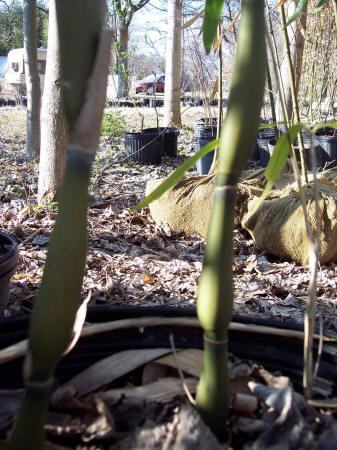Bamboo Facts
Bamboos very seldom bloom. Some only bloom every 75 to 100 years. With this characteristic, little seed is produced. The rhizome root system is basically an underground stem. The rhizome will spread underground and in the following seasons, stem buds will emerge. Many people are confused by this growth pattern. They don’t understand that the original plant was located in one place and a few years later it has multiplied and spread.
All plants have specific maintenance requirements. If bamboo growth is to be limited to a specific location, rhizome control is necessary. This can best be accomplished by cutting the new shoots with a lawn mower as the emerge in spring and early summer. The new shoots are very tender at this time. If the plant has no leaf surface, photosynthesis does not occur and no carbohydrates are produced, thus no plant growth in that area. If more extreme measures are warranted, annual root pruning can be performed. This is much simpler than it sounds. Annually during late August or September, root prune to a depth of 8 - 10 inches with a sharp spade along the line to be maintained. A straight cut downward is needed. Do not skip areas as all of the rhizome must be cut to limit its growth.
Root Barriers: Barriers DO NOT WORK. They will all eventually fail. They are very expensive and labor intensive to install. They are not health for the plants. Your plants will become root bound, much like a plant in a flower pot that has been allowed to over grow its soil space.
Clumping bamboos do not perform well in Middle Tennessee. The winter hardy clumpers don’t like 95 degree Fahrenheit summers, and the tropical clumpers will freeze at near 18 degrees Fahrenheit every year. We average -10 degrees Fahrenheit, in Nashville.
Bamboo is not the monster that some claim. It is not for every location, much like Canadian Hemlock and Colorado Spruce installed 4 feet away from the foundation of the house. Always choose the right plant in the right place.

